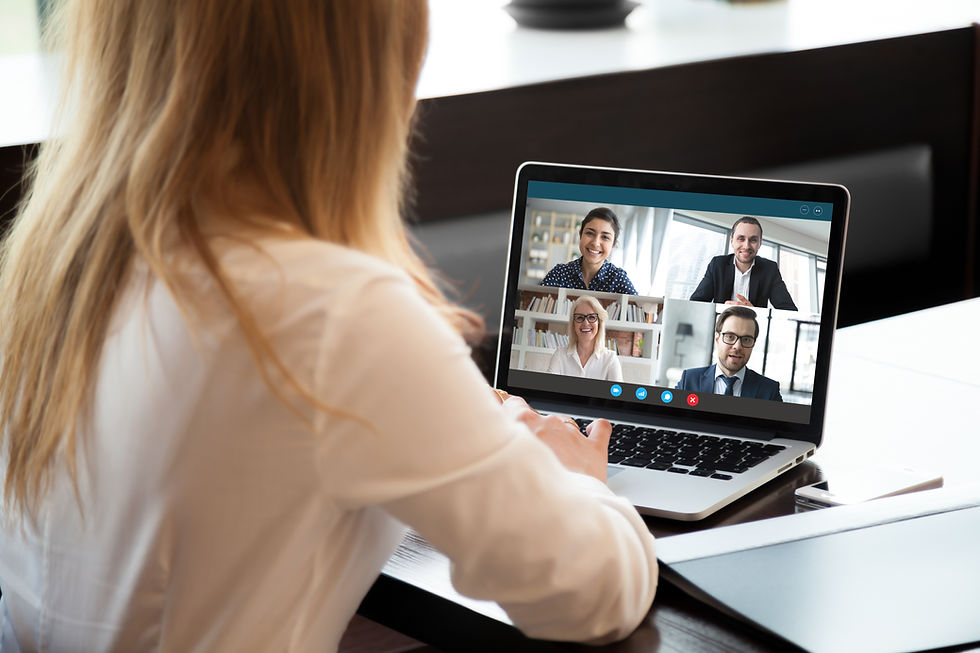The Future of Office Space Post-Pandemic
- The Logic Group
- Apr 22, 2021
- 6 min read
COVID-19 has dramatically changed the way we work across all industries. Many workplaces have become unrecognisable compared to just over a year ago. But perhaps none more so than offices. With social distancing, remote working, video conferencing and flexible hours just some of the measures introduced since March 2020 to control the spread of the virus in the UK, many offices and even entire buildings and business districts have become ghost towns.

With the lockdown restrictions gradually easing, what will office workspaces look like in a post-pandemic world? Which of the new ways of working will stick? How can you prepare for these changes and how can businesses best adapt?
The New Normal – Is Video Conferencing Here to Stay?
Inevitably, there will be some things that have now become so intrinsically part of our ‘new normal’ that they will become a mainstay in our working lives. Zoom and Teams meetings immediately spring to mind here. These programs have revolutionised the way we conduct business, reducing the need for business travel, reducing business expenses and allowing people to work from home while also staying connected and involved.
Despite being widely available before the pandemic, these programs were not extensively used by businesses. Perhaps caused by a reluctance to embrace new technology or a belief that people needed to be in the same room to do business. Sometimes drastic change comes as a result of forced necessity rather than gradual evolution.

On their own blog, Zoom describes this move towards video communications technology at the start of the pandemic: “baby steps toward digital transformation suddenly had to become leaps and bounds, with people reimagining their entire day-to-day practically overnight.” This video conferencing platform alone jumped from less than 10 million daily users in December 2019 to over 300 million participants per day in April 2020.
Research suggests that around 80% of those working from home enjoy doing so and wish to continue working from home, to some extent, when lockdown is lifted. Businesses and employees have adapted and video conferencing may be the way to ensure that remote working can be a mainstay for the long-term.
Hot-Desking and Office Layouts
If remote working is to continue in some way, how will this affect office layout? There seems little sense in allocating an office or even just a desk to someone who will only be physically present a couple of days a week, especially in expensive central-city office buildings.
Hot-desking was an idea that had started to become popular a few years ago but had maybe hit a stumbling block – not enough employees were working remotely to allow this trend to really take flight. Post-lockdown, this could be a great way for businesses to use their office space more effectively. Having a pool of desks available for use as needed would be more economical than providing an individual desk for each employee, regardless of how much time they spend in the office.
Let’s say a business has 100 employees: on any given day
- 40 are in the office
- 30 are working from home
- 20 are in external or internal meetings
- 10 are on leave or off sick
Rather than buying or leasing an office space with the square footage for 100 fixed desks as well as the necessary individual offices and meeting rooms, this business could have a flexible hot desking area with seating for 40-50, video conferencing room, meeting and break-out rooms and individual offices as required. This would potentially reduce their floorspace needs by around 50% and their costs would fall in line with that.
A hot-desking area with moveable furniture would also allow team members to sit with the best people for their tasklist on that day whereas a fixed desk scenario does not offer this flexibility or facilitate a more collaborative way of working.
The Highs and Lows of Remote Working
According to research by McKinsey & Co, 68% of employees claim they are at least as productive, if not more productive working from home than they had been in an office environment. Many employees have been freed the burden of long commutes and hefty travel expenses and have gained a greater balance between their personal and professional lives. With less time spent travelling, people have been able to spend more time with their families and dedicated more time to their own personal interests.
Many companies now offer positions which are fully based on remote working from home. Some organisations think that fewer locational constraints will allow them to access new talent and recognise that a certain amount of remote working may actually create a stronger company culture.
However, there is a real concern that job satisfaction and productivity may suffer from an extended lack of lunch break chats, face-to-face meetings and social engagements. Can unplanned moments of collaboration and sparks of genius truly thrive online forever? How can younger employees be mentored and their talents developed without in-person exposure to the company and the wider team? Has remote working succeeded to this point only because it has been necessary? Is home working being viewed as temporary rather than permanent?
Health & Safety in the Office
The guidance is not yet clear on exactly what health and safety measures will be standard as the country returns to work and how this will change when the vaccine rollout is complete. To begin with, it’s likely that all employees will be required to wear a face mask in shared office spaces and sanitise their hands upon entry as well as on a regular basis throughout the day. Office spaces should be regularly cleaned, especially touchpoints such as door handles, desks should be positioned so that employees are seated at least 2m apart and screens used if needed.

Consideration may also need to given to which employees should return to the office, when and where they should enter and exit the building, when visitors should be allowed, whether there is sufficient airflow and if social distancing can be maintained as staff and visitors move through the space
As the vaccine programme continues, it’s likely that all these measures will gradually ease but individuals will likely have their own ideas of what they’re comfortable with. The chances are, the nation will be more cautious than before and employees may insist on a greater level of protection against exposure to viruses in the workplace.
What’s Right for Your Business?
The best businesses have always been the ones that can adapt. Leading organizations will question their long-held assumptions about how they should conduct their day-to-day operations and will examine the role of the office in a post-pandemic world. There is no ‘one-size-fits-all’ answer since every business is different. Question everything. Involve your employees, ask questions, invite feedback and ideas.
Whatever decisions you make, ensure there is a level of flexibility built in. Make adjustments to your business and your office layout to best reflect the current circumstances and keep checking to see how this is working for you. Change-management is likely to be required, regardless of whether you go back to the way things were before the pandemic or implement a whole host of changes. Monitor, measure, predict and adapt.
Redesign the Workplace to Support your Priorities
Regardless of the industry or business location, a typical office has a certain look and feel: it is often composed of a number of personal offices, desks or cubicles, small meeting rooms, a larger boardroom and a range of shared facilities. Statistically, very few offices have been deliberately designed to support the specific priorities of the individual business. Perhaps now is a good time to rethink office space entirely…
For example, if the primary purpose of your company’s office space is to facilitate moments of collaboration between team members rather than individual work, should more of the office be devoted to collaboration rooms? How should these areas look and feel? Where should they be located? How can the design, layout and furniture of these rooms best stimulate the necessary outcomes such as teamworking, creativity and innovation? Should all these rooms be the same or should they all be different? Can you use plants, textures, colour, temperature and even scents to better the performance of your employees?
One thing looks certain, in the office of the future, technology will be key. Organisations will need to consider how to manage the boundaries between being physically present in the office and those remote working. According to a recent survey by Zoom, 84% of businesses agreed that “video conferencing will continue to be essential for their business operations beyond the pandemic.”
In-office videoconferencing may no longer involve those in the office sitting around a table while others watch from a screen at the side. All participants should be able to participate effectively. Always-on videoconferencing, virtual whiteboards and collaborative online team projects may quickly become the new normal – bridging the gap between office working and remote working.
To discuss how to implement positive changes to your office space in a post-COVID19 environment, contact us for a free 30 minute consultation. We will be happy to discuss your business goals, concerns, ideas and challenges and are confident we can help you maximise the potential of your office to achieve your potential.
.png)


Comments